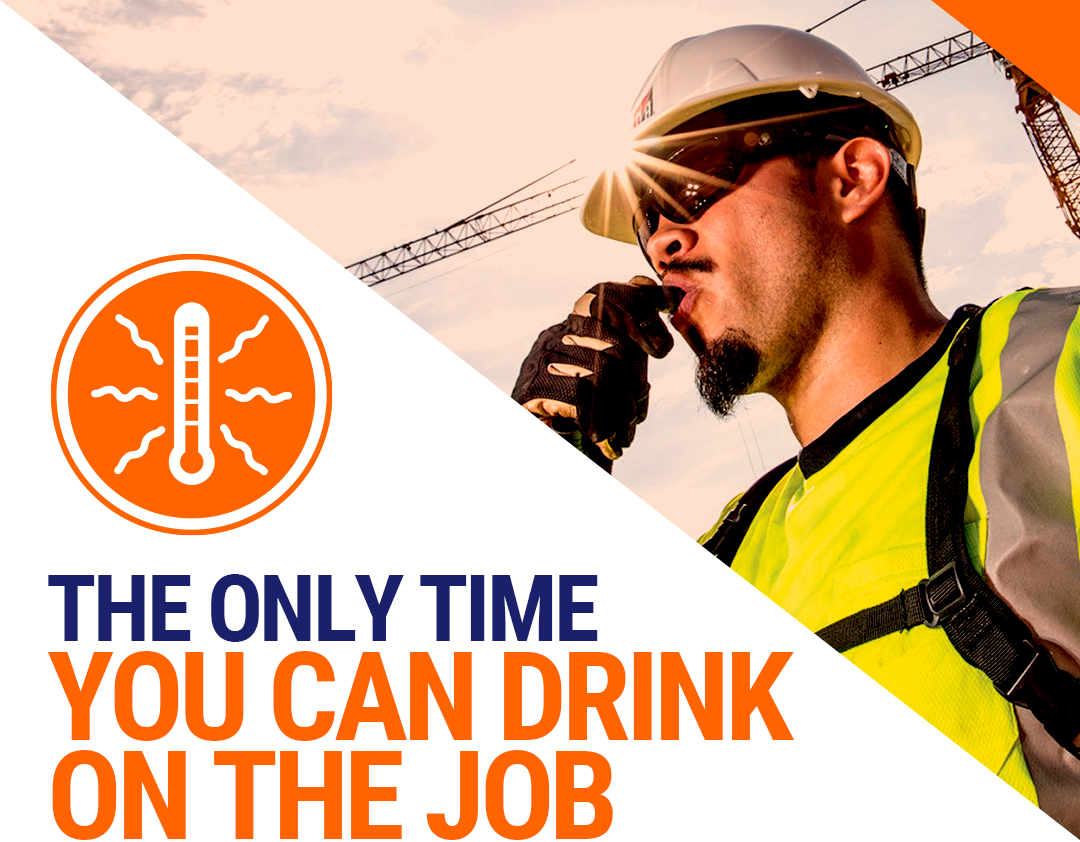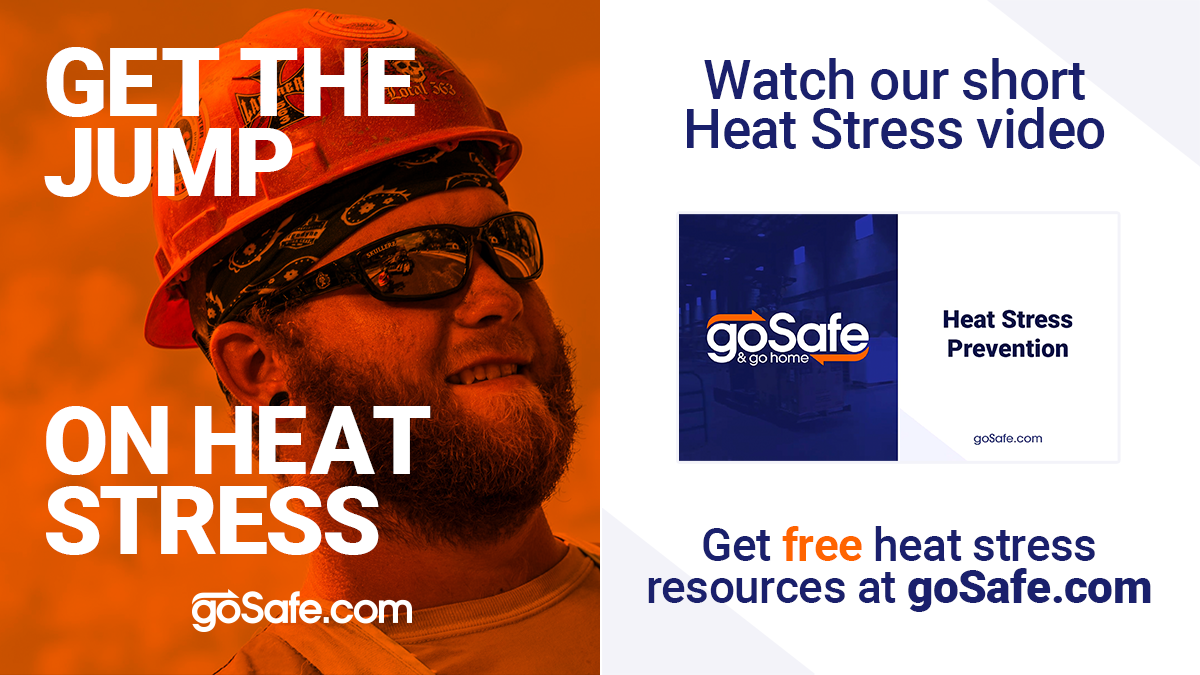Our bodies are constantly producing heat. Whether it’s the metabolism in our bodies working to break down food or the electrical impulses firing on all cylinders with the amount of physical work we do - we’re constantly generating heat.
As a result, keeping cool on hot days can prove to be a challenge. Often times, workers don’t realize they’re dehydrated or facing heat stress until it’s too late. Electrolytes play a big role in our health, but first let’s look at the dangers we’re facing.
Factors That Increase Risk
Heat stroke often occurs when the body reaches 104° F, which can cause cellular damage after just 30 minutes. Before anyone ever starts working in extremely hot conditions it’s important that they be educated on how to protect themselves. Risk factors include low fluid consumption, heavy PPE, high air temperatures, humidity, prolonged exposure to direct sunlight, indoor radiant heat sources and limited air movement. Knowing the risk factors of heat illnesses and educating workers on how to prevent and treat them is critical to their well being.
Heat Illnesses, Symptoms and Treatment
Heat stress can result in a number of different illnesses such as: heat stroke, heat exhaustion, heat cramps and heat rash.
Heat stroke is the most dangerous and occurs when the body’s temperature regulating system fails and temperature rises to critical levels. Some of the symptoms could be confusion, loss of consciousness, seizures, very high body temperature, dry skin or profuse sweating. If a worker shows signs of possible heat stroke you should call 911, as it is a life-threatening condition. Get emergency medical help! In the meantime, move the worker to a shaded area, remove outer clothing, wet the worker with cool water and circulate the air speed to cooling. Place cold, wet clothes or ice all over the body. Another option is to soak the worker’s clothing with cold water to bring body temperatures down to regular levels.
Heat exhaustion is the second most dangerous heat illness. Symptoms of heat exhaustion include: headache, nausea, dizziness, weakness, irritability, thirst, heavy sweating, elevated body temperature and decreased urine output. Workers suffering from heat exhaustion should be taken to a clinic or emergency room. Workers should be removed from hot areas and given water to drink. Remove any unnecessary clothing and cool the workers head, neck and face with cold compresses or water.
Heat Cramps are muscle pains caused by physical labor in a hot work environment. This is often a result of the loss of body salts and fluid during sweating. If someone is suffering from heat cramps, they should replace lost fluids by drinking water and having snacks that replace the electrolytes. If cramps do not subside within one hour, seek medical help.
Heat Rash is the most common problem in hot work environments. It’s caused by sweating and looks like a red cluster or small red blisters on the skin. They often appear on the neck, upper chest, in the groin and in elbow creases. The best treatment is to provide a cooler, less humid work environment. The rash area should be kept dry and ointments and creams should not be applied.
Prevention
Ideally, you should prevent heat illnesses before ir ever becomes a problem. Educating your workers on workplace heat stress and how to spot, prevent and treat heat illnesses is essential.
- Provide workers with plenty of cool water in convenient, visible locations close to the work area
- Remind workers to frequently drink small amounts of water before they become thirsty to maintain good hydration
- Workers should eat regular meals and snacks, as they provide enough salt and electrolytes to replace those lost through sweating
- Make it known that it is equally dangerous to drink extreme amounts of water. No more than 12 quarts in a 24 hour period
- Monitor weather conditions daily and move outside projects to cooler times of the day
Electrolytes
Finally! We’re talking about electrolytes. If you didn’t know, electrolytes are minerals that carry an electrical charge. They play a big part in how your muscles function. Drinking more water without replacing lost electrolytes can cause dilution and deplete what little remaining electrolytes you have left. So, do your employees need electrolytes? The answer is fairly simple: absolutely.
Let’s take a look at 3 key electrolytes.
Calcium - As you might know, calcium is a key player in bone development. But, did you also know that it aids in nerve transmission and muscle growth. A lack in calcium can contribute to muscle cramps, such as the heat cramps mentioned before.
Chloride - Chloride helps regulate the balance of acid and alkali levels in our blood. Lack of chloride can lead to poor muscle contraction and difficulty digesting. On a worksite this can prove extremely dangerous, as workers are usually doing heavy lifting and need to be able to digest meals to replenish electrolytes.
Potassium - Potassium plays a part in how nerves transmit signals and muscles contract. It also helps to regulate water balance. We lose quite a bit of potassium when we sweat, so it’s important to replenish.
Electrolytes help make sure your muscles are working properly and that your energy levels stay up. It’s important to make sure you stay properly nourished and hydrated so that you’re constantly replenishing what you lose. There are plenty of electrolyte rich drinks that help keep you properly hydrated: Sqwincher, Gatorade, Powerade, Propel and Vitaminwater to name a few. Sqwincher Zero Fast Packs are a great resource to have - just mix it with your water and you have an instant electrolyte replenisher.
It’s important to remember that prevention should play a bigger role than treatment. While it’s definitely important to be conscious of how to treat heat illnesses, it’s important to prevent them. Making sure workers have access to the replenishment they need will ensure your workplace continues to run smoothly and safely.







